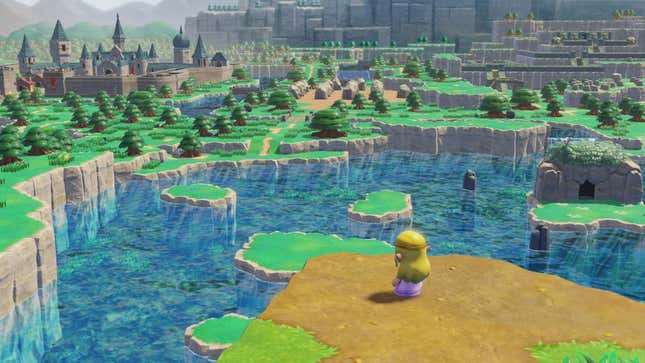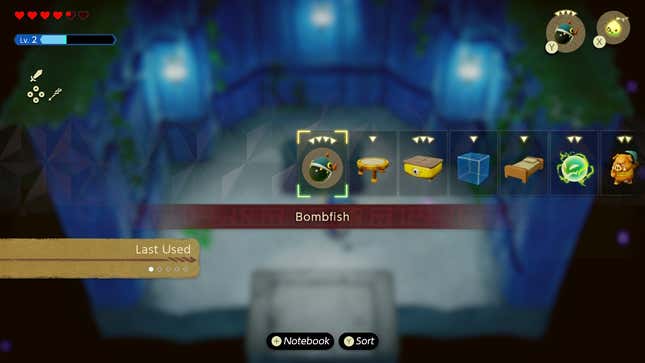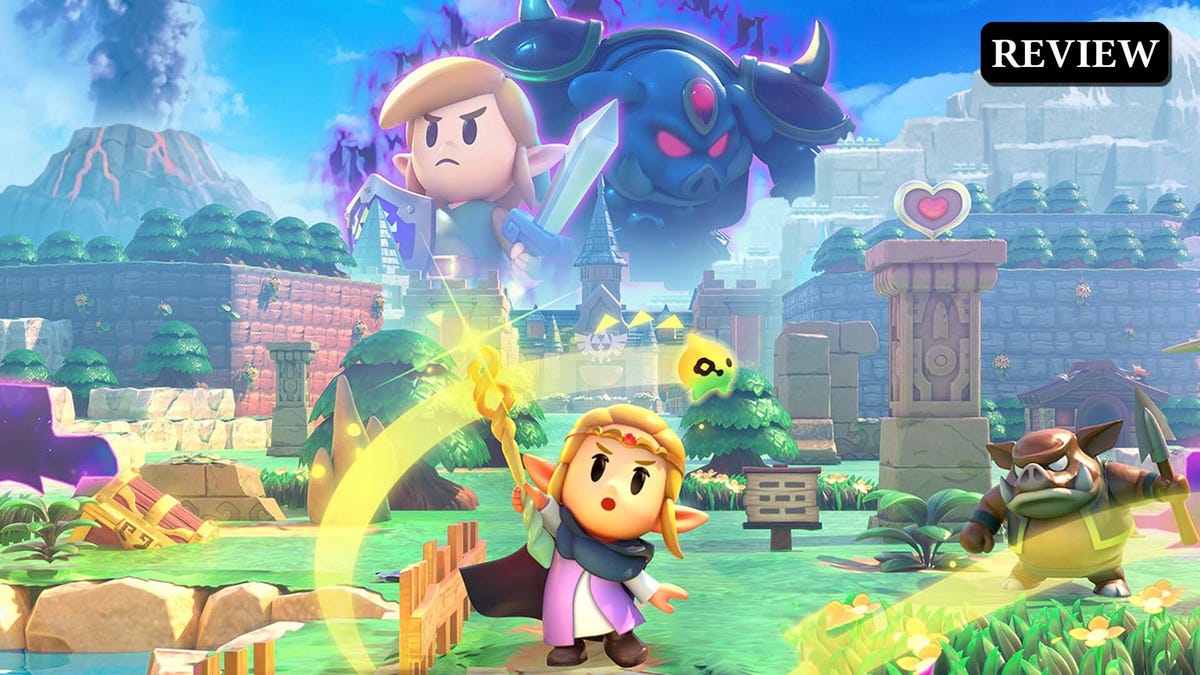How do you follow up on some of the most critically acclaimed games of the past decade? Many thought that Nintendo couldn’t surpass the sheer open-world wonder and physics toy-box creativity that made The Legend of Zelda: Breath of the Wild such a revelation. However, Nintendo seemed to do just that with Tears of the Kingdom, introducing a host of new ways for players to interact with the world and expanding the already vast realm of Hyrule both into the skies above and into the depths below, arguably improving so much on its extraordinary predecessor as to make it obsolete.
In between those two games, we also got Link’s Awakening, a 2019 remake of a classic Game Boy adventure that replaced the original’s pixel art with toy-like and dioramic visuals, trying to recreate the retro feel for a modern age. The Legend of Zelda: Echoes of Wisdom takes that same charming art direction and applies it to a completely original story featuring our beloved Hyrule princess, Zelda. It also attempts to combine the player-driven creativity and problem-solving from both Breath of the Wild and Tears of the Kingdom with classic top-down Zelda gameplay, and it works! Mostly.
Echoes of Wisdom’s story finds Hyrule threatened by dark rifts engulfing the land, trapping its inhabitants, including our usual green-tunic-wearing hero Link, in a frozen time-space continuum. Zelda, with her fairy-like companion Tri, set out to dispel these rifts and set those trapped free. With Link himself imprisoned in one of these rifts, it falls to Zelda, in a first for a mainline game in the franchise, to rescue the land herself.

The main difference between playing as Zelda and stepping back into Link’s boots is that she doesn’t fight enemies directly with your typical sword and shield, at least most of the time. With Tri’s magic, Zelda is able to create “echoes,” which are clones of items and monsters she’s encountered throughout Hyrule. She can summon things like beds, tables, and chairs, but also creatures like electric-force-field-inducing blobs and goblins with spears (or moblins, in the Hyrule parlance). This is where Echoes of Wisdom’s freeform creativity comes into play.
When traversing the game’s dungeons and puzzles, my go-to strategy was always to stack beds on top of each other, forming a makeshift bridge to cross wide gaps. It was similar to a strategy I used in Tears of the Kingdom, where I would just stick logs together to make a bridge. While this frequently helped me in the early game, I eventually had to think more creatively in later dungeons. For example, when gaps were too wide for my bed bridge, I stood at the edge of my incomplete creation and also used an echo that, when picked up, blew a windstream opposite of Zelda’s direction that propelled her far enough to reach the other side. When your solutions actually end up working, there’s a huge sense of accomplishment, and Echoes of Wisdom provides those feelings in spades, making you feel satisfied and confident throughout.
When Echoes begins, Tri’s magic is limited so there’s a hard cap on how many echoes you can have out at a time. But the game’s progression system feels quite natural; as Tri becomes more capable, she and Zelda clear more rifts throughout the story and the cap increases, allowing Zelda to summon more echoes at once.
Echoes of Wisdom feels something like a puzzle game, reminiscent of those older series entries that had intricately constructed dungeons you had to not just fight your way through but to solve, and in this game, you can progress through them with her echoes, which almost act as the key, traversal-aiding items that you’d otherwise obtain in games past.

To further maintain that classic Zelda feel, our intrepid heroine has limited access to Link’s iconic swordfighter repertoire. For a limited time, she can enter a “swordsman mode” that lets her swing a sword, shoot arrows, and throw bombs, all of the things Link could do when he was the protagonist. At times, this felt like a concession to longtime Zelda players who just want to return to Link’s gameplay. In the context of Echoes of Wisdom’s mechanics, it feels quite overpowered, even if it’s only active until Zelda’s energy meter runs out. Part of Zelda’s fighting style involves using the echoes to do the dirty work for her. That means risking your bomb-making fish echo being destroyed by an enemy before it can go off. The swordfighter mode essentially becomes like a “press to win” button because Zelda can just spam bombs. Additionally, Zelda can continually down smoothies that she can make with various ingredients throughout Hyrule to recharge her energy meter. This method effectively lets her enter and stay in swordfighter mode more frequently and for longer. As a result, this unfortunately ends up trivializing most of Zelda’s arsenal of echoes, as swordfighter mode makes quick work of even bosses.
Combat is at its best when you rely on echoes, and finding new echoes is half the fun of actually using them. Every time I defeated a new enemy, I was excited to scan them and create echoes of them. It felt like I was playing Pokémon, trying to collect as many as I could. However, that leads me into Echoes of Wisdom’s most prominent issue: echo management.
There are dozens upon dozens of these echoes, and it’s a total pain in the butt to cycle through your entire list of all of them while looking for the particular one you need for your particular situation. There are some helpful sorting tools, such as being able to organize by your most recently used or the latest one you acquired, but I wish the game allowed you to manually organize your collection of echoes.

Exploration also plays a huge role in Echoes of Wisdom. The map looks a lot like that of A Link to the Past, feeling like a sort of homage to the franchise’s past. The game is surprisingly long as well, taking about 25-30 hours to just complete the main story. It’s filled with dozens of side quests and optional dungeons. Some of these side quests are quick and easy, like finding and killing a monster that has the ability to summon rain and showing it to a local townsperson, or searching for missing chickens scattered throughout a town and putting them back into a farm. Others, meanwhile, are quite elaborate, including a multi-step one in which you’re eventually rewarded with the powerful ability to build robots that have humongous AOE attacks. They’re a huge boon, especially in boss fights.
I felt like the rewards you get for completing side quests are much more worthwhile than in most role-playing games. While you’ll probably just earn more rupees to spend at shops, you’re also likely to encounter a new echo along the way that could prove helpful later on. In fact, some of the most useful echoes are stowed away in optional dungeons, which makes exploration even more rewarding. Early on, I came across a giant plant that could propel itself into monsters, constantly dealing damage with its appendages. It was an incredibly powerful echo at that point in the game, and let me steamroll many of the early game bosses.
While exploration is fun and rewarding, I do wish Zelda’s running speed was faster. She runs abysmally slow and it’s incredibly frustrating. She has a little spin move that doesn’t do any damage, but when combined with running, actually makes her move much more quickly than her usual sprint. So I was constantly mashing the right bumper button while moving to break into a makeshift spin-dash whenever I was running out in the wild.
Echoes of Wisdom successfully combines the feel of earlier Zelda games with the new creative direction that the modern entries have been going in. By fusing the classic key item progression of older Zelda games with the more modern, player-driven problem-solving of Tears of the Kingdom and Breath of the Wild, Echoes of Wisdom creates something both familiar, yet distinct from every other game in the series so far. Also, our long-suffering Hyrulian princess finally gets some time in the spotlight, and that is a welcome change of pace.
.

